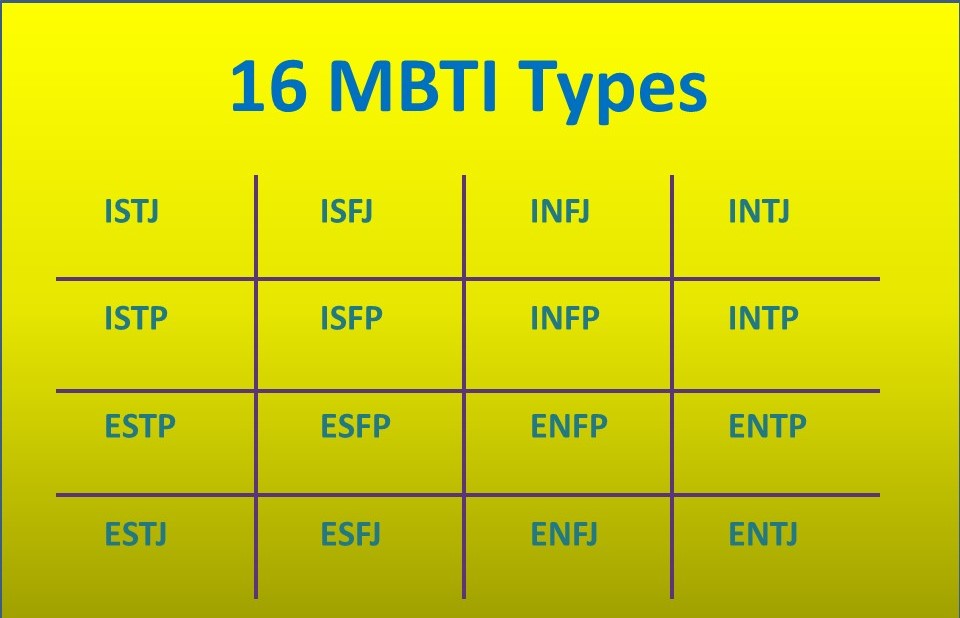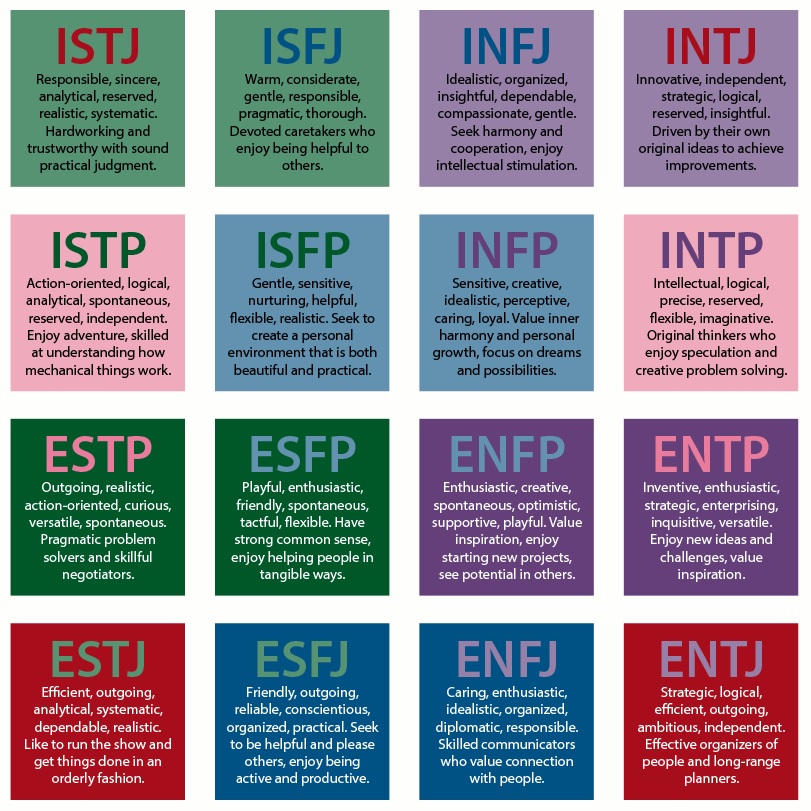This is a resource page on MBTI - there are 16 Types of MBTI personalities. Find out which are you. This resource page is frequently referred to in our MBTI Teambuilding Workshops to help participants get more information about their MBTI Type.
When you hear someone identify as an INTJ or an ESTP, do you ever wonder what those enigmatic-sounding letters might mean? These people are discussing their personality type according to the Myers-Briggs Type Indicator (MBTI).
The Myers-Briggs Personality Type Indicator is a self-report questionnaire used to identify a person’s personality type, strengths, and preferences. The MBTI assessment/questionnaire was developed by Isabel Myers and her mother Katherine Briggs based on their investigation of Carl Jung’s theory of personality types. The MBTI inventory is one of the most widely used psychological assessments available today.

This article describes the 16 various MBTI types, how they were developed, and how the Myers-Briggs personality typing system functions.
The Development of the Myers-Briggs Assessment
Jung’s notion of psychological types captivated Myers and Briggs, and they both realized that the theory could be used in the actual world. They started investigating and creating an indication that may be used to understand individual differences during World War II.
Myers and Briggs believed that by assisting people in understanding themselves, they might aid them in making better career decisions and leading healthier, happier lives.
The two women started evaluating the inventory on friends and relatives after Myers established the original paper-and-pencil version of it in the 1940s. Over the following two decades, they continued to fully develop the instrument.
MBTI – Overview of the Myers-Briggs Asessment
People are classified into one of 16 personality types based on their responses to the inventory’s questions. The MBTI Assessment is designed to help users better understand their own personalities, including their likes, dislikes, strengths, and weaknesses as well as potential career inclinations and interpersonal compatibility. In fact, applying the knowledge and insights of your MBTI tests can help you in engaging others, forging closer relationships, and improve your presentation skills. Read below:
How MBTI assessment can help you in your presentation skills
The 16 MBTI personality types
The Myers-Briggs Type Indicator® (MBTI®) Step I is based on Carl Jung’s theory of psychological type. It indicates your personality preferences in four dimensions:
- Where you focus your attention – Extraversion (E) or Introversion (I)
- The way you take in information – Sensing (S) or INtuition (N)
- How you make decisions – Thinking (T) or Feeling (F)
- How you deal with the world – Judging (J) or Perceiving (P)

Do you know your MBTI Type?
Contact us for an MBTI Assessment.
The 4 letters that make up your personality type can help you to understand yourself and your interactions with others. To find out what your MBTI personality type is you need to complete the MBTI questionnaire and take part in a feedback session from a qualified MBTI practitioner. Contact 36 HR Training & Consultancy for your MBTI assessment.
There is no “best” or “better” personality type than another. It is not a device made to search for abnormalities or dysfunction. Its sole purpose is to assist you in discovering more about yourself. Four separate scales make up the actual questionnaire.
Extraversion (E) vs Intraversion (I)
Jung first used the extraversion-introversion dichotomy in his theory of personality types to describe how people react to and engage with the world around them. Although most people are familiar with these phrases, the way they are used in the MBTI is a little different.
Extraverts, or extroverts as they are frequently misspelled, are “outward-turning” and have a tendency to be action-oriented, like regular social interaction, and feel energised after doing so. It is common for introverts to be “inward-turning,” enjoy significant and deep social contacts, and feel rejuvenated after some time alone.
Although we all exhibit some extraversion and some introversion, most people seem to favor one over the other.
Sensing (S) vs Intuition (N)
On this pair, we examine how people receive information about their surroundings. Everyone spends time perceiving and intuiting depending on the situation, just like extraverts and introverts do. People typically tend to be dominant in one area or the other, according to the MBTI.
People who love sensing tend to pay close attention to reality, especially to what their senses can tell them. They want to gain first-hand experience and tend to concentrate on the specifics and facts. People who value intuition tend to pay closer attention to patterns and impressions. They like speculating, envisioning the future, and contemplating irrational beliefs. To varying degrees, everyone of us displays extraversion and introversion, yet most people tend to have an dominant Sensing or Intuition.
Thinking (T) vs Feeling (F)
This pair focuses on how people arrive at judgments using information gleaned from their intuitive or sensory faculties. People who prefer to ponder tend to place more value on facts and unbiased information.
When considering a choice, they frequently exhibit consistency, reason, and objectivity. People and emotions are more likely to be taken into account when making decisions by those who prefer feeling. likely to favor one over the other on a general basis.
Judging (J) vs Perceiving (P)
The last pair measures how individuals typically interact with the outside world. Those who have a tendency to judge desire order and decisive action. Perceiving-inclined people are more adaptive, flexible, and open-minded. The other scales are affected by these two tendencies.
The 16 MBTI (Myers Briggs) Types

Do you know what is your MBTI Type?
Each MBTI type carries 4 letters and the overview for each type is written below. You may click on each of the 16 MBTI types below to get additional detailed information.
ISTJ – The Inspector: Reserved and practical, they tend to be loyal, orderly, and traditional.
ISTP – The Crafter: Highly independent, they enjoy new experiences that provide first-hand learning.
ISFJ – The Protector: Warm-hearted and dedicated, they are always ready to protect the people they care about.
ISFP – The Artist: Easy-going and flexible, they tend to be reserved and artistic.
INFJ – The Advocate: Creative and analytical, they are considered one of the rarest Myers-Briggs types.3
INFP – The Mediator: Idealistic with high values, they strive to make the world a better place.
INTJ – The Architect: High logical, they are both very creative and analytical.4
INTP – The Thinker: Quiet and introverted, they are known for having a rich inner world.
ESTP – The Persuader: Out-going and dramatic, they enjoy spending time with others and focusing on the here-and-now.
ESTJ – The Director: Assertive and rule-oriented, they have high principles and a tendency to take charge.
ESFP – The Performer: Outgoing and spontaneous, they enjoy taking center stage.
ESFJ – The Caregiver: Soft-hearted and outgoing, they tend to believe the best about other people.
ENFP – The Champion: Charismatic and energetic, they enjoy situations where they can put their creativity to work.
ENFJ – The Giver: Loyal and sensitive, they are known for being understanding and generous.
ENTP – The Debater: Highly inventive, they love being surrounded by ideas and tend to start many projects (but may struggle to finish them).
ENTJ – The Commander: Outspoken and confident, they are great at making plans and organizing projects.
Taking the Myers-Briggs Type Indicator can provide a lot of insight into your personality, which is probably why the instrument has become so popular. Even without taking the formal questionnaire, you can probably immediately recognize some of these tendencies in yourself.
According to the Myers & Briggs Foundation, it is important to remember that no one type is ‘superior’ and that every type has value, and blind spots.
For more info, contact us for MBTI Team Building Workshops, or one to one Executive Coaching.
For detailed reading of each of the 16 MBTI types, please click below. Enjoy!
Readers who find this resource useful may also be interested in finding out the different MBTI Team Development activities or different Personality Profiling Workshops.
